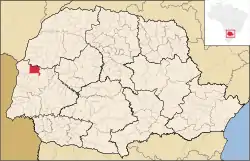Palotina
Palotina is a municipality in western Paraná state, located around 60 kilometers from the border with Paraguay.[2]
Palotina | |
|---|---|
 Flag | |
 | |
| Coordinates: 24°17′00″S 53°50′23″W | |
| Government | |
| • Mayor | Jucenir Leandro Stentzler |
| Area | |
| • Total | 651 km2 (251 sq mi) |
| Elevation | 320 m (1,050 ft) |
| Population (2020 [1]) | |
| • Total | 32,121 |
| • Density | 44.5/km2 (115/sq mi) |
Location
The population is 32,121 inhabitants, as of the 2020 estimate. Owing to highly fertile land,[2] the city is a flourishing agricultural hub and a base for two major agricultural companies: C. Vale and I. Rieddi. Another highlight of Palotina is the campus of the Federal University of Paraná (UFPR). There is also one private university, the UESPAR (União de Ensino Superior do Paraná).
The municipality contains the 385 hectares (950 acres) São Camilo State Park, a conservation unit originally created as a biological reserve in 1990.[3]
History
Settlement in the area started in 1953 when Pinho e Terras started to colonize the area. The settlement began to grow and on July 25, 1960 attained the status of municipality. Pinho e Terras approach to colonization was called exemplary,[2] but in the early 1960s the colonists were besieged by gunmen hired by the "new landowners" affiliated with state governor and Socialist Democratic Party boss Moises Lupion.[4] The federal government moved in a regiment of border guards to pacify the area and in 1963 re-nationalized the disputed lands. The colonists had to buy back their own land.[2]
Agriciltural economy of Palotina relies on production of corn, wheat and soybean. A 1969 survey placed Palotina in the cluster of most efficient agricultural communities in Brazil.[5] According to authors of the study, higher productivity in this cluster stemmed from raising pigs, which accounts for 68% of its output. 82% of lands were allotted to fodder crops rather than traditional rice, bean and cotton.[5]
Nowadays, Palotina is a near 30k inhabitants municipality with an agroindustrial economy and a hopeful future. Most of the population, around 68%, have Italian ancestry and about 13% of the community have German ancestry.
Climate
Humid subtropical climate of Palotina (Cfa in Köppen climate classification) is characterized by humid and hot summers, while winters are cool. Precipitation is moderate all year long.
| Palotina, Records | ||||||||||||||||||||||||||||||||||||||||||||||||||||||||||||
|---|---|---|---|---|---|---|---|---|---|---|---|---|---|---|---|---|---|---|---|---|---|---|---|---|---|---|---|---|---|---|---|---|---|---|---|---|---|---|---|---|---|---|---|---|---|---|---|---|---|---|---|---|---|---|---|---|---|---|---|---|
| Climate chart (explanation) | ||||||||||||||||||||||||||||||||||||||||||||||||||||||||||||
| ||||||||||||||||||||||||||||||||||||||||||||||||||||||||||||
| ||||||||||||||||||||||||||||||||||||||||||||||||||||||||||||
Footnotes
- IBGE 2020
- Foweraker, p. 120.
- Parque Estadual de São Camilo (in Portuguese), IAP: Instituto Ambiental do Paraná, retrieved 2016-04-29
- Lupion, according to Foweraker, p. 108, practiced "double baptism" of land, awarding the title of already occupied farmland to the highest bidder.
- Foweraker, p 46.
References
- Joe Foweraker (2002). The Struggle for Land: A Political Economy of the Pioneer Frontier in Brazil from 1930 to the Present Day. Cambridge University Press. ISBN 0-521-52600-0.
Further reading
- Pedro Reginato (1979). História de Palotina, 1954-1979 (in Portuguese). Pallotti.